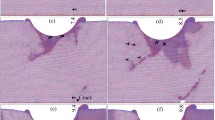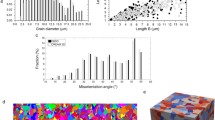Abstract
Nanotwinned polycrystals exhibit an excellent strength-ductility combination due to nanoscale twins and grains. However, nanotwin-assisted grain coarsening under mechanical loading reported in recent experiments may result in strength drop based on the Hall-Petch law. In this paper, a phase-field model is developed to investigate the effect of coupled evolutions of twin and grain boundaries on nanotwin-assisted grain growth. The simulation result demonstrates that there are three pathways for coupled motions of twin and grain boundaries in a bicrystal under the applied loading, dependent on the amplitude of applied loading and misorientation of the bicrystal. It reveals that a large misorientation angle and a large applied stress promote the twinning-driven grain boundary migration. The resultant twin-assisted grain coarsening is confirmed in the simulations for the microstructural evolutions in twinned and un-twinned polycrystals under a high applied stress.
Similar content being viewed by others
References
HALL, E. O. The deformation and ageing of mild steel: III discussion of results. Proceedings of the Physical Society Section B, 64, 495–502 (1951)
LU, L., SHEN, Y. F., CHEN, X. H., QIAN, L. H., and LU, K. Ultrahigh strength and high electrical conductivity in copper. Science, 304, 422–426 (2004)
YANG, F. and YANG, W. Crack growth versus blunting in nanocrystalline metals with extremely small grain size. Journal of the Mechanics and Physics of Solids, 57, 305–324 (2009)
SCHIOTZ, J., DI TOLLA, F. D., and JACOBSEN, K. W. Softening of nanocrystalline metals at very small grain sizes. nature, 391, 561–563 (1998)
KOCK, C. C. Structural nanocrystalline materials: an overview. Journal of Materials Science, 42, 1403–1414 (2007)
SHEN, Y. F., LU, L., LU, Q. H., JIN, Z. H., and LU, K. Tensile properties of copper with nano-scale twins. Scripta Materialia, 52, 989–994 (2005)
LU, L., SCHWAIGER, R., SHAN, Z. W., DAO, M., LU, K., and SURESH, S. Nano-sized twins induce high rate sensitivity of flow stress in pure copper. Acta Materialia, 53, 2169–2179 (2005)
LU, L., CHEN, X., HUANG, X., and LU, K. Revealing the maximum strength in nanotwinned copper. Science, 323, 607–610 (2009)
CHEN, X. H. and LU, L. Work hardening of ultrafine-grained copper with nanoscale twins. Scripta Materialia, 57, 133–136 (2007)
LU, K., LU, L., and SURESH, S. Strengthening materials by engineering coherent internal boundaries at the nanoscale. Science, 324, 349–352 (2009)
WEI, Y. J. Scaling of maximum strength with grain size in nanotwinned fcc metals. Physical Review B, 83, 132104 (2011)
WEI, Y. J., LI, Y., ZHU, L., LIU, Y., LEI, X., WANG, G., WU, Y., MI, Z., LIU, J., and WANG, H. Evading the strength-ductility trade-off dilemma in steel through gradient hierarchical nanotwins. Nature Communications, 5, 3580 (2014)
LI, X., WEI, Y. J., LU, L., LU, K., and GAO, H. Dislocation nucleation governed softening and maximum strength in nano-twinned metals. nature, 464, 877–880 (2010)
ZHU, T., LI, J., SAMANTA, A., KIM, H. G., and SURESH, S. Interfacial plasticity governs strain rate sensitivity and ductility in nanostructured metals. Proceedings of the National Academy of Sciences, 104, 3031–3036 (2007)
ZHU, L., QU, S., GUO, X., and LU, J. Analysis of the twin spacing and grain size effects on mechanical properties in hierarchically nanotwinned face-centered cubic metals based on a mechanism-based plasticity model. Journal of the Mechanics and Physics of Solids, 76, 162–179 (2015)
LI, J., ZHANG, J. Y., LIU, G., and SUN, J. New insight into the stable grain size of nanotwinned Ni in steady-state creep: effect of the ratio of effective-to-internal stress. International Journal of Plasticity, 85, 172–189 (2016)
LU, K. Stabilizing nanostructures in metals using grain and twin boundary architectures. Nature Reviews Materials, 1, 16019 (2016)
ANDRIEVSKI, R. A. Review of thermal stability of nanomaterials. Journal of Materials Science, 49, 1449–1460 (2013)
PENG, H. R., GONG, M. M., CHEN, Y. Z., and LIU, F. Thermal stability of nanocrystalline materials: thermodynamics and kinetics. International Materials Reviews, 62, 303–333 (2017)
TRELEWICZ, J. R. and SCHUH, C. A. Grain boundary segregation and thermodynamically stable binary nanocrystalline alloys. Physical Review B, 79, 094112 (2009)
ABDELJAWAD, F. and FOILES, S. M. Stabilization of nanocrystalline alloys via grain boundary segregation: a diffuse interface model. Acta Materialia, 101, 159–171 (2015)
CHOOKAJORN, T., MURDOCH, H. A., and SCHUH, C. A. Design of stable nanocrystalline alloys. Science, 337, 951–954 (2012)
KIRCHHEIM, R. Grain coarsening inhibited by solute segregation. Acta Materialia, 50, 413–419 (2002)
SABER, M., KOCH, C. C., and SCATTERGOOD, R. O. Thermodynamic grain size stabilization models: an overview. Materials Research Letters, 3, 65–75 (2015)
KOCH, C., SCATTERGOOD, R., DARLING, K., and SEMONES, J. Stabilization of nanocrystalline grain sizes by solute additions. Journal of Materials Science, 43, 7264–7272 (2008)
GIANLLA, D. S., VAN PETEGEM, S., LEGROS, M., BRANDSTETTER, S., VAN SWYGEN-HOVEN, H., and HEMKER, K. J. Stress-assisted discontinuous grain growth and its effect on the deformation behavior of nanocrystalline aluminum thin films. Acta Materialia, 54, 2253–2263 (2006)
HEO, T. W. and CHEN, L. Q. Phase-field modeling of displacive phase transformations in elastically anisotropic and inhomogeneous polycrystals. Acta Materialia, 76, 68–81 (2014)
ZHANG, H.W., HEI, Z. K., LIU, G., LU, J., and LU, K. Formation of nanostructured surface layer on AISI 304 stainless steel by means of surface mechanical attrition treatment. Acta Materialia, 51, 1871–1881 (2003)
CHEN, W., YOU, Z., TAO, N., JIN, Z., and LU, L. Mechanically-induced grain coarsening in gradient nano-grained copper. Acta Materialia, 125, 255–264 (2017)
ROMERO, P. A., JARVI, T. T., BECKMANN, N., MROVEC, M., and MOSELER, M. Coarse graining and localized plasticity between sliding nanocrystalline metals. Physical Review Letters, 113, 036101 (2014)
HASLAM, A., MOLDOVAN, D., YAMAKOV, V., WOLF, D., PHILLPOT, S., and GLEITER, H. Stress-enhanced grain growth in a nanocrystalline material by molecular-dynamics simulation. Acta Materialia, 51, 2097–2112 (2003)
LI, J. C. Mechanical grain growth in nanocrystalline copper. Physical Review Letters, 96, 215506 (2006)
LEGROS, M., GIANOLA, D. S., and HEMKER, K. J. In situ TEM observations of fast grainboundary motion in stressed nanocrystalline aluminum films. Acta Materialia, 56, 3380–3393 (2008)
LIN, Y., WEN, H., LI, Y., WEN, B., LIU, W., and LAVERNIA, E. J. An analytical model for stress-induced grain growth in the presence of both second-phase particles and solute segregation at grain boundaries. Acta Materialia, 82, 304–315 (2015)
TONKS, M. and MILLETT, P. Phase field simulations of elastic deformation-driven grain growth in 2D copper polycrystals. Materials Science and Engineering: A, 528, 4086–4091 (2011)
RUPERT, T. J., GIANOLA, D. S., GAN, Y., and HEMKER, K. J. Experimental observations of stress-driven grain boundary migration. Science, 326, 1686–1690 (2009)
GLUSHKO, O. and CORDILL, M. The driving force governing room temperature grain coarsening in thin gold films. Scripta Materialia, 130, 42–45 (2017)
CAHN, J. W., MISHIN, Y., and SUZUKI, A. Coupling grain boundary motion to shear deformation. Acta Materialia, 54, 4953–4975 (2006)
YAMAKOV, V., WOLF, D., PHILLPOT, S. R., and GLEITER, H. Deformation twinning in nanocrystalline Al by molecular dynamics simulation. Acta Materialia, 50, 5005–5020 (2002)
WANG, P., XU, S., LIU, J., LI, X., WEI, Y., WANG, H., GAO, H., and YANG, W. Atomistic simulation for deforming complex alloys with application toward TWIP steel and associated physical insights. Journal of the Mechanics and Physics of Solids, 98, 290–308 (2017)
BEYERLEIN, I. J., ZHANG, X., and MISRA, A. Growth twins and deformation twins in metals. Annual Review of Materials Research, 44, 329–363 (2014)
LUO, X. M., ZHU, X. F., and ZHANG, G. P. Nanotwin-assisted grain growth in nanocrystalline gold films under cyclic loading. Nature Communications, 5, 3021 (2014)
LUO, X. M., LI, X., and ZHANG, G. P. Forming incoherent twin boundaries: a new way for nanograin growth under cyclic loading. Materials Research Letters, 5, 95–101 (2017)
LI, J., ZHANG, J. Y., JIANG, L., ZHANG, P., WU, K., LIU, G., and SUN, J. Twinning/detwinning-mediated grain growth and mechanical properties of free-standing nanotwinned Ni foils: grain size and strain rate effects. Materials Science and Engineering: A, 628, 62–74 (2015)
FAN, D. and CHEN, L. Q. Computer simulation of grain growth using a continuum field model. Acta Materialia, 45, 611–622 (1997)
HEO, T.W., WANG, Y., BHATTACHARYA, S., SUN, X., HU, S., and CHEN, L. Q. A phase-field model for deformation twinning. Philosophical Magazine Letters, 91, 110–121 (2011)
HU, S. Y., HENAGER, C. H., and CHEN, L. Q. Simulations of stress-induced twinning and de-twinning: a phase field model. Acta Materialia, 58, 6554–6564 (2010)
JIN, Y. M. Domain microstructure evolution in magnetic shape memory alloys: phase-field model and simulation. Acta Materialia, 57, 2488–2495 (2009)
HONG, X., GODFREY, A., and LIU, W. Challenges in the prediction of twin transmission at grain boundaries in a magnesium alloy. Scripta Materialia, 123, 77–80 (2016)
SINHA, S. and GURAO, N. P. In situ electron backscatter diffraction study of twinning in commercially pure titanium during tension-compression deformation and annealing. Materials and Design, 116, 686–693 (2017)
GONG, M., HIRTH, J. P., LIU, Y., SHEN, Y., and WANG, J. Interface structures and twinning mechanisms of twins in hexagonal metals. Materials Research Letters, 5, 449–464 (2017)
Acknowledgements
We would like to thank Yujie WEI for helpful discussion and valuable suggestions.
Author information
Authors and Affiliations
Corresponding author
Additional information
Project supported by the National Natural Science Foundation of China (No. 11672285), the Strategic Priority Research Program of the Chinese Academy of Sciences (No. XDB22040502), the Collaborative Innovation Center of Suzhou Nano Science and Technology, and the Fundamental Research Funds for the Central Universities
Rights and permissions
About this article
Cite this article
Da, Y., Lu, Y. & Ni, Y. Phase-field simulation of the coupled evolutions of grain and twin boundaries in nanotwinned polycrystals. Appl. Math. Mech.-Engl. Ed. 39, 1789–1804 (2018). https://doi.org/10.1007/s10483-018-2393-7
Received:
Revised:
Published:
Issue Date:
DOI: https://doi.org/10.1007/s10483-018-2393-7




